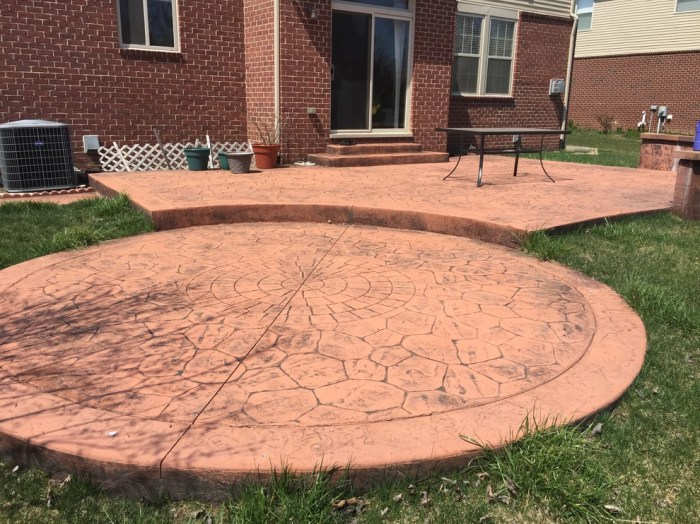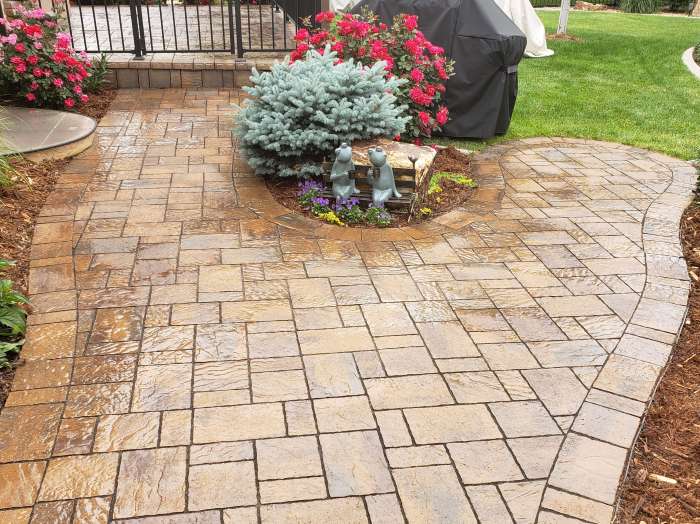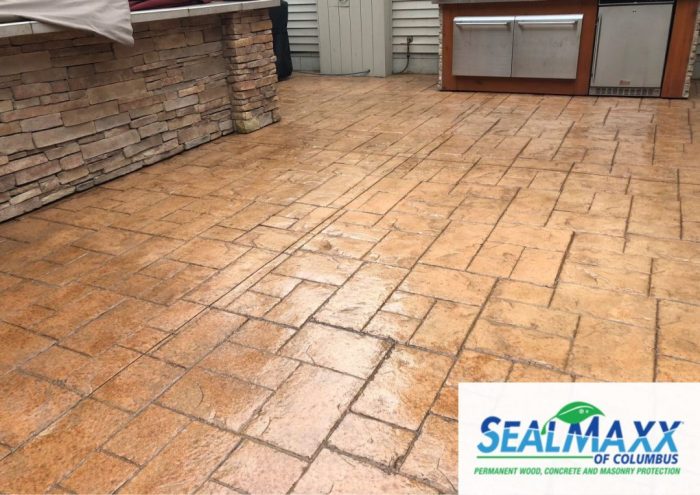Sealing stamped concrete patios is a crucial step in maintaining their beauty and longevity. By applying a protective layer, you can shield your patio from stains, wear, and fading, ensuring it remains a stunning outdoor living space for years to come.
This guide will delve into the types of sealers available, help you choose the right one for your patio, and provide a step-by-step guide to the sealing process. Additionally, we’ll address common problems and offer maintenance tips to keep your sealed patio looking its best.
Benefits of Sealing Stamped Concrete Patio
Sealing a stamped concrete patio offers numerous advantages that enhance its durability, aesthetics, and ease of maintenance.
One of the primary benefits of sealing is protection against stains. Spills, dirt, and other contaminants can easily penetrate unsealed concrete, leaving unsightly marks and discoloration. Sealing forms a protective barrier that repels liquids and prevents stains from setting in, ensuring the patio’s pristine appearance.
Protection Against Wear and Tear
- Sealing also safeguards the patio against wear and tear caused by foot traffic, heavy furniture, and weather conditions. Unsealed concrete is susceptible to cracking, chipping, and erosion, especially in areas with high pedestrian traffic or extreme temperature fluctuations.
- The sealant acts as a protective layer, absorbing impact and preventing the concrete from breaking down. This prolongs the patio’s lifespan and maintains its structural integrity.
Prevention of Fading
- Exposure to sunlight can cause unsealed concrete to fade over time, losing its vibrant colors and aesthetic appeal.
- Sealants contain UV inhibitors that protect the concrete from the sun’s harmful rays, preserving its color and preventing premature aging.
Types of Sealers for Stamped Concrete Patios
When selecting a sealer for your stamped concrete patio, there are three main types to consider: water-based, solvent-based, and penetrating sealers. Each type offers unique advantages and drawbacks, so it’s important to understand their properties before making a decision.
Water-Based Sealers
Water-based sealers are the most environmentally friendly option, as they contain low levels of volatile organic compounds (VOCs). They are also relatively easy to apply and clean up. However, water-based sealers are not as durable as other types of sealers and may need to be reapplied more frequently.
Solvent-Based Sealers
Solvent-based sealers are more durable than water-based sealers and provide a higher level of protection against stains and wear. However, they contain higher levels of VOCs and can be more difficult to apply and clean up. Solvent-based sealers are also more expensive than water-based sealers.
Penetrating Sealers
Penetrating sealers soak into the concrete, rather than forming a surface coating. This makes them very durable and resistant to wear and tear. However, penetrating sealers can be more difficult to apply than other types of sealers and may not provide as much protection against stains.
How to Choose the Right Sealer for Your Patio: Sealing Stamped Concrete Patio
Selecting the right sealer for your stamped concrete patio is crucial to ensure its longevity and aesthetic appeal. Consider the following factors: Climate:Harsh weather conditions can impact the performance of sealers. Opt for sealers specifically designed for your local climate, accounting for extreme temperatures, UV exposure, and precipitation levels.
Traffic:High-traffic areas require durable sealers that can withstand wear and tear. Choose sealers with high abrasion resistance to prevent premature fading or peeling. Desired Finish:Sealers come in various finishes, including glossy, matte, and natural. Choose a finish that complements the desired aesthetic of your patio and enhances its overall appearance.
Assessing Patio Condition
Before applying a sealer, assess the condition of your patio. Look for cracks, chips, or discoloration. If any significant damage is present, it may require repairs before sealing. Cleaning the patio thoroughly with a pressure washer or cleaner will ensure proper adhesion of the sealer.
Step-by-Step Guide to Sealing a Stamped Concrete Patio
Protecting your stamped concrete patio with a sealer is essential for maintaining its beauty and longevity. Follow this comprehensive step-by-step guide to ensure a successful sealing process.
Preparation
Before applying the sealer, the patio must be thoroughly cleaned and prepared. Use a pressure washer to remove dirt, debris, and any existing sealers. Allow the patio to dry completely.
Application, Sealing stamped concrete patio
Apply the sealer according to the manufacturer’s instructions. Use a brush, roller, or sprayer to apply the sealer evenly over the entire surface of the patio. Allow the first coat to dry completely before applying a second coat.
Curing
Once the sealer has been applied, allow it to cure for the recommended time specified by the manufacturer. During this time, avoid foot traffic or placing objects on the patio. Once cured, the sealer will provide a protective barrier against the elements and enhance the appearance of your stamped concrete patio.
| Step | Action | Safety Precautions |
|---|---|---|
| 1 | Clean the patio with a pressure washer | Wear safety glasses and gloves. Keep children and pets away from the area. |
| 2 | Allow the patio to dry completely | Check the weather forecast to avoid sealing in moisture. |
| 3 | Apply the sealer according to the manufacturer’s instructions | Follow the application instructions carefully. Use a brush, roller, or sprayer to apply the sealer evenly. |
| 4 | Allow the first coat to dry completely before applying a second coat | Check the manufacturer’s instructions for drying time. |
| 5 | Allow the sealer to cure for the recommended time | Avoid foot traffic or placing objects on the patio during this time. |
Troubleshooting Common Sealing Problems
Sealing a stamped concrete patio can enhance its durability and aesthetics. However, various issues can arise during the sealing process. Understanding these problems and their solutions is crucial for a successful sealing project.Common problems encountered during sealing include peeling, discoloration, and efflorescence.
Peeling
Peeling occurs when the sealer detaches from the concrete surface. It can be caused by inadequate surface preparation, using an incompatible sealer, or applying the sealer too thickly. To resolve peeling, remove the existing sealer and thoroughly clean the surface.
Use a compatible sealer and apply it in thin, even coats.
Discoloration
Discoloration can occur due to the sealer reacting with the concrete or external factors like UV exposure. To avoid discoloration, choose a sealer that is compatible with the concrete and provides UV protection. If discoloration occurs, try using a mild cleaner or consult a professional for guidance.
Efflorescence
Efflorescence is the formation of white, powdery deposits on the concrete surface. It is caused by moisture and soluble salts in the concrete. To prevent efflorescence, ensure the concrete is properly cured before sealing. Use a sealer that resists moisture penetration and consider applying a moisture barrier to the subgrade.
Maintenance and Care for Sealed Stamped Concrete Patios
Maintaining and caring for your sealed stamped concrete patio is crucial to preserving its beauty and extending its lifespan. Regular cleaning, proper sealing techniques, and occasional repairs will ensure that your patio remains a stunning outdoor space for years to come.
Recommended Cleaning Methods and Products
Regular cleaning is essential to remove dirt, grime, and other debris that can accumulate on the patio surface. Use a mild detergent mixed with water and a soft-bristled brush or sponge. Avoid using harsh chemicals or abrasive cleaners, as they can damage the sealer.
For tougher stains, consult a professional cleaner who specializes in stamped concrete.
Final Summary
Sealing your stamped concrete patio is an investment in its beauty and durability. By following the steps Artikeld in this guide, you can protect your patio from the elements and enjoy its vibrant colors and intricate patterns for many years to come.



